Notes: Colonialism & Tribal Societies | Social Studies & Pedagogy Paper 2 for CTET & TET Exams - CTET & State TET PDF Download
Most tribes had customs and rituals that were very different from those laid down by Brahmans. These societies also did not have the sharp social divisions that were characteristic of caste societies. All those who belonged to the same tribe thought of themselves as sharing common ties of kinship. However, this did not mean that there were no social and economic differences within tribes.
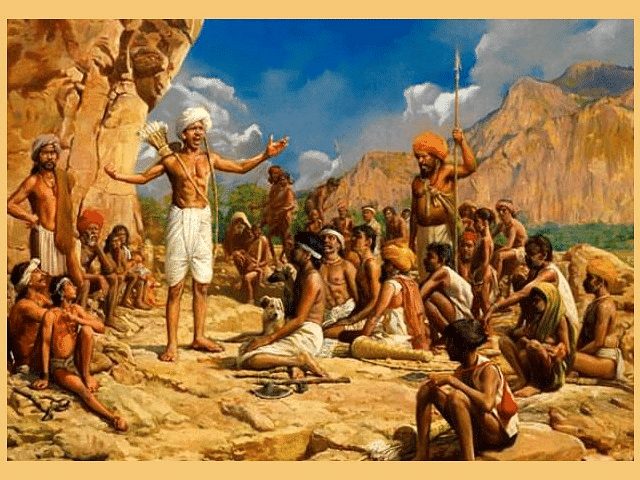
- In 1895, a man named Birsa was seen roaming the forests and villages of Chottanagpur in Bihar. People said he had miraculous powers – he could cure all diseases and multiply grain. Birsa himself declared that God had appointed him to save his people from trouble, free them from the slavery of dikus (outsiders). Soon thousands began following Birsa, believing that he was bhagwan (God) and had come to solve all their problems.
- Birsa was born in a family of Mundas – a tribal group that lived in Chottanagpur. But his followers included other tribals of the region – Santhals and Oraons. All of them in different ways were unhappy with the changes they were experiencing and the problems they were facing under British rule. Their familiar ways of life seemed to be disappearing, their livelihoods were under threat, and their religion appeared to be in danger.
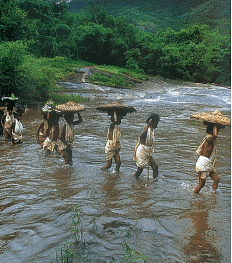 Women of the Dongria Kandha tribe in Orissa wade through the river on the way to the market
Women of the Dongria Kandha tribe in Orissa wade through the river on the way to the market
How did Tribal Groups Live?
Tribal people in differeny parts of India were involved in a variety of activities.
Some Were Jhum Cultivators
Some of them practised jhum cultivation, that is, shifting cultivation. This was done on small patches of land, mostly in forests. The cultivators cut the tree tops to allow sunlight to reach the ground, and burnt the vegetation on the land to clear it for cultivation. They spread the ash from the firing, which contained potash, to fertilise the soil. They used the axe to cut trees and the hoe to scratch the soil in order to prepare it for cultivation. They broadcast the seeds, that is, scattered the seeds on the field instead of ploughing the land and sowing the seeds. Once the crop was ready and harvested, they moved to another field. A field that had been cultivated once was left fallow for several years, Shifting cultivators were found in the hilly and forested tracts of north-east and central India. The lives of these tribal people depended on free movement within forests and on being able to use the land and forests for growing their crops. That is the only way they could practise shifting cultivation.
Some Were Hunters And Gatherers
- In many regions tribal groups lived by hunting animals and gathering forest produce. They saw forests as essential for survival. The Khonds were such a community living in the forests of Orissa. They regularly went out on collective hunts and then divided the meat amongst themselves. They ate fruits and roots collected from the forest and cooked food with the oil they extracted from the seeds of the sal and mahua. They used many forest shrubs and herbs for medicinal purposes, and sold forest produce in the local markets. The local weavers and leather workers turned to the Khonds when they needed supplies of kusum and palash flowers to colour their clothes and leather.
- Tribal groups often needed to buy and sell in order to be able to get the goods that were not produced within the locality. This led to their dependence on traders and moneylenders. Traders came around with things for sale, and sold the goods at high prices. Moneylenders gave loans with which the tribals met their cash needs, adding to what they earned. But the interest charged on the loans was usually very high. So for the tribals, market and commerce often meant debt and poverty. They therefore came to see the moneylender and trader as evil outsiders and the cause of their misery.
Some Herded Animals
Many tribal groups lived by herding and rearing animals. They were pastoralists who moved with their herds of cattle or sheep according to the seasons. When the grass in one place was exhausted, they moved to another area. The Van Gujjars of the Punjab hills and the Labadis of Andhra Pradesh were cattle herders, the Gaddis of Kulu were shepherds, and the Bakarwals of Kashmir reared goats.
Some Took to Settled Cultivation
Even before the nineteenth century, many from within the tribal groups had begun settling down, and cultivating their fields in one place year after year, instead of moving from place to place. They began to use the plough, and gradually got rights over the land they lived on. In many cases, like the Mundas of Chottanagpur, the land belonged to the clan as a whole. All members of the clan were regarded as descendants of the original settlers, who had first cleared the land. Therefore, all of them had rights on the land. Very often some people within the clan acquired more power than others, some became chiefs and others followers. Powerful men often rented out their land instead of cultivating it themselves.
How did Colonial Rule Affect Tribal Lives?
The lives of tribal groups changed during British rule.
What Happened to Tribal Chiefs?
Before the arrival of the British, in many areas the tribal chiefs were important people. They enjoyed a certain amount of economic power and had the right to administer and control their territories. In some places they had their own police and decided on the local rules of land and forest management. Under British rule, the functions and powers of the tribal chiefs changed considerably. They were allowed to keep their land titles over a cluster of villages and rent out lands, but they lost much of their administrative power and were forced to follow laws made by British officials in India. They also had to pay tribute to the British, and discipline the tribal groups on behalf of the British. They lost the authority they had earlier enjoyed amongst their people, and were unable to fulfil their traditional functions.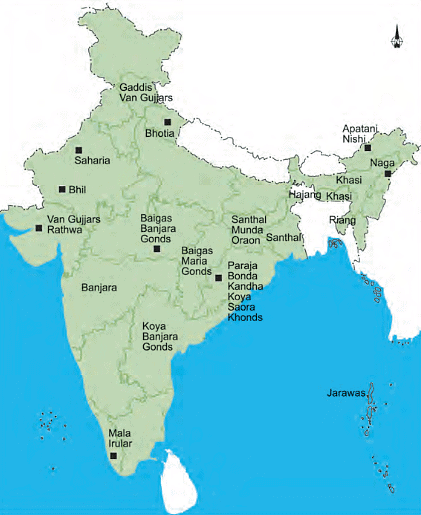 Location of some Tribal Groups of India
Location of some Tribal Groups of India
What Happened to the Shifting Cultivators?
- The British were uncomfortable with groups who moved about and did not have a fixed home. They wanted tribal groups to settle down and become peasant cultivators.
- Settled peasants were easier to control and administer than people who were always on the move.
- The British also wanted a regular revenue source for the state. So they introduced land settlements – that is, they measured the land, defined the rights of each individual to that land, and fixed the revenue demand for the state. Some peasants were declared landowners, others tenants.
- The British effort to settle jhum cultivators was not very successful. Settled plough cultivation is not easy in areas where water is scarce and the soil is dry. In fact, jhum cultivators who took to plough cultivation often suffered, since their fields did not produce good yields. So the jhum cultivators in north-east India insisted on continuing with their traditional practice. Facing widespread protests, the British had to ultimately allow them the right to carry on shifting cultivation in some parts of the forest.
Forest Laws and their Impact
- The life of tribal groups, was directly connected to the forest. So changes in forest laws had a considerable effect on tribal lives. The British declared that forests were state property. Reserved forest produced timber which the British wanted. In these forests people were not allowed to move freely, practise jhum cultivation. Collect fruits or hunt animals.
- Once the British stopped the tribal people from living inside forests, they faced the shortage of labour to cut trees for railway sleepers and to transport logs.
- Colonial officials came up with a solution. they decided that they would give jhum cultivators small patches of land in the forests and allow them to cultivate these on the condition that those who lived in the villages would have to provide labour to the forest department and look after the forests.
- Many tribal groups reacted against the colonial forest laws. They disobeyed the new rules, continued with practices that were declared illegal and at times rose in open rebellion. Such was the revolt of Songram Sangma in 1906 in Assam and the forest satyagraha of the 1930s in the Central Provinces.
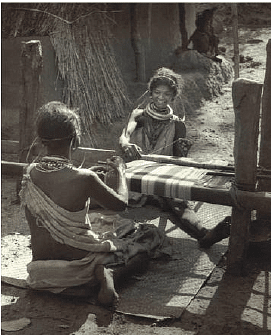 Godara Women Weaving
Godara Women Weaving
The Problem with Trade
- During the nineteenth century, tribal groups found that traders and moneylenders were coming into the forests more often, wanting to buy forest produce, offering cash loans, and asking them to work for wages. It took tribal groups some time to understand the consequences of what was happening.
- In the eighteenth century, Indian silk was in demand in European markets. The fine quality of Indian silk was highly valued and exports from India increased rapidly. As the market expanded, East India Company officials tried to encourage silk production to meet the growing demand.
- Hazaribagh, in present-day Jharkhand, was an area where the Santhals reared cocoons. The traders dealing in silk sent in their agents who gave loans to the tribal people and collected the cocoons. The growers were paid Rs 3 to Rs 4 for a thousand cocoons. These were then exported to Burdwan or Gaya where they were sold at five times the price. The middlemen – so called because they arranged deals between the exporters and silk growers – made huge profits. The silk growers earned very little. Understandably, many tribal groups saw the market and the traders as their main enemies.
The Search for Work
The plight of the tribals who had to go far away from their homes in search of work was even worse. From the late nineteenth century, tea plantations started coming up and mining became an important industry. Tribals were recruited in large numbers to work the tea plantations of Assam and the coal mines of Jharkhand. They were recruited through contractors who paid them miserably low wages, and prevented them from returning home.
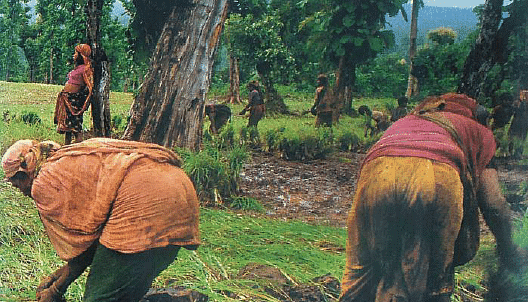 Bhil women cultivating in a forest in Gujarat
Bhil women cultivating in a forest in Gujarat
A Closer Look
Through the nineteenth and twentieth centuries, tribal groups in different parts of the country rebelled against the changes in laws, the restrictions on their practices, the new taxes they had to pay, and the exploitation by traders and moneylenders.
- The Kols rebelled in 1831-32. (Bengal)
- Santhals rose in revolt in 1855. (Bihar, Bengal and Jharkhand)
- The bastar Rebellion in 1910 (Central India)
- The Warli Revolt in Maharashtra in 1940.
Birsa Munda
- Birsa was born in the mid-1870s. As an adolescent. Birsa heard tales of the Munda uprisings of the past and saw the sirdars (leaders) of the community urging the people to revolt. They talked of a golden age when the Mundas had been free of the oppression of dikus and ancestral right of community would be restored. They reminded people of the need to win back their kingdom.
- From the sermons of missionaries, Brisa heard that it was possible for the Mundas to attain the Kingdom of Heaven, and regain their lost rights. Birsa also spent some time in the company of a prominent Vaishnav preacher. He wore the sacred thread, and begain to value the importance of purity and piety.
- Birsa was deeply influenced by many of the ideas he came in touch with in his growing-up years. He aimed at reforming tribal society. He urged the Mundas to give up drinking liquor, clean their village, and stop believing in witchcraft and sorcery. Birsa also turned against missionaries and Hindu landlords. He saw them as outside forces that were ruining the Munda way of life.
- 1895 Birsa urged his followers to recover their glorious past. Birsa also wanted people to once again work on their land, settle down and cultivate their fields.
- British got worried of the political aim of the Birsa movement which wanted to drive out missionaries, monelender Hindu landlords, and the government and set up a Munda Raj with Birsa at its head. The movement identified all these forces as the cause of the misery the Mundas were suffering. British officials arrested Birsa in 1895, convicted him on charges of rioting and jailed him for two years.
- When Birsa was released in 1897 he began touring the villages to gather support. He used traditional symbols and language to rouse people against the dikus and the Europeans. Birsa’s followers began targeting the symbols of diku and European power. They attacked police stations and churches, and raided the property of moneylenders and zamindars. They raised the white flag as a symbol of Birsa Raj.
- In 1900 Birsa died of cholera and the movement faded out.
- The movement was significant in at least two ways. First it forced the colonial government to introduce laws so that the land of the triblas could not be easily taken over by dikus.
Second - it showed once again that the tribal people had the capacity to protest against injustice and express their anger against colonial rule.
Colonialism and Tribal Societies
New Words
- Anthropology: Study of human societies and customs.
- Fortress: A small fort
- Geology: Science related to earth's crust.
- Rebellion: Organized open resistance of authority
- Tribe: Subdivision of a race of people
Meaning of a Tribe
A tribe is a group of people having certain common traditional characteristics. The characteristics are:
- Every tribe has a particular name, for example, Gonds, Ahoms, Santhals, Goaros, Khasi, etc.
Characteristics of Tribes
- Members of a tribe live in the same geographical area.
- Members of atribe have strong emotional ties.
- Members of a tribe speak a common language and dialect.
- Members of a tribe follow same rules regarding marriage and occupation.
- Members of atribe have certain traditional restrictions.
- Tribal people in general are non-vegetarian.
Different forms of Tribal Societies
- Hunters and food collectors.
- Cattle Breeders
- Cultivation
- Factory workers
General Living Conditions of Tribes
- They are very backward.
- Majority of them depend on gathering food from the forests, breeding cattle and hunting.
- They live in scarcity.
- They are very poor and mostly in debt.
Social Problems
- Most tribes practise what may be called reverse dowry. The male partner has to pay the bride's father.
- Child marriages are common.
- Tribal culture has been on the decline.
- Tribal people face problems of communication when they come in contact with other people.
Tribal Development in India: Important Steps
- Provisions in the Constitution for the welfare of tribal people.
- Reservations in Parliament and State Assemblies.
- Reservation in jobs.
Tribal Revolts at a Glance
- The peasants' and tribal revolts began in the late eighteenth century and were frequent throughout the nineteenth century. Among first was the Sanyasi Rebellion (1770), when as a result of a devastating famine, a large number of 'sanyasis' and 'fakirs', along with many village artisans – including the severely exploited silk weavers of bengal – and thousands of unemployed soldiers from the Mughal army, rebelled and fought against the British.
- In 1820–21, the Ho tribal peasants of Chhotanagpur in Bihar rose twice against the British rulers, the local money leaders and zamindars.
- The Oraons–another tribal community – rebelled in the years 1820, 1832 and again in 1890.
- To quell the ferocious Kol revolt of 1831–32, British troops were deployed from as far off places as calcutta, Danapur and Benaras.
- The Santhal uprising of 1855–57 was one of most widespread. Covering the states of Bihar, Orissa and Bengal, the Santhals were joined on many occasions by poor and landless peasants of lower castes.
- As many as 20,000 rebels ere massacred in a final battle against the British. The heoic struggle by the Mundas of Ranchi (1895) inspired folkloric visions of a new society.
British Policies towards Tribes
- The rule of the East India Company exercised a great influence on the economics, social and peaceful lives of the tribal people. The policies of the Company were formed and implemented in such a manner that the tribal people considered it a great danger to their very existence. The economic policies encouraged the zamindars, money-lenders and merchants to exploit the tribal people.
Major causes of Tribal Revolts
- The East India Company introduced a new system of land settlement. This created great unrest among the tribals.
- Plundering the Forest Wealth :- The tribal people in general depended upon the forest for their livelihood. The government activities tended to exercise a complete control over the forest wealth. This led to anger among the tribals.
- Tyranny of the Landlords :- The landlords put heavy demands on the tribal people. They levied a variety of unfair and high taxes on them. The British encouraged the landlords to do so.
- The Christian missionaries were also active in some of the tribal areas and sometimes created hostile feeling among the tribes.
- The tribes mostly resented the instrusion of these outsiders in their society. Their resentement resulted in occasional violent outbursts against the British government called tribal revolts.
Tribal Revolts in Eastern India
- In 1829, the Khasis, a primitive tribe inhabiting the hilly region in the north-west on the border of Assam revolted against the British.
- The British desired to construct a road which passed through the lands of the Khasis. It was resented by the Khasis.
- The Khasi chiefs numbering nearly thirty finally decided to turn out the British not only from the hills but also from the plains of Assam and organised themselves under Bar Manik.
- The British suppressed it brutally, established a sort of economic blockade of the territory of Khasis and systematically burnt and plundered Khasi villages.
- The Nagas revolted against the British in 1849 and could be suppressed only in 1850-51.
- The Kukis who inhabited the Lushai hills and the hill region of Manipur and Tripura and engaged themselves in hunting, attacked the British territories in 1829, 1844 and 1849. They were finally forced to submit in 1850.
- The Khonds occupied a large tract of territory called Khondmals, neighbouring Orissa.
- They led a primitive life with their own social customs. They feared that the British would annex their lands and exact forced labour. Therefore, they revolted in 1846.
- The Santhals inhabiting the territory of Bihar adjoining Bengal revolted in 1855–56. Their main grievances were against the oppression of the mahajans and traders from Bengal and upper India who swarmed their territory and exploited them ruthlessly. But when they felt that the government did noting to safeguard their interest, they turned against it. They rose in revolt under the leadership of two brothers, Sido and Kanhu with a view to turn out the British from their territory and establish their own rule.
Tribal Revolts in Central India (Chota Nagpur)
- Kolarian tribe of Chota Nagpur was ruled by petty chieftains. They did not like the encroachment of their territory by the British. One of them, the Raja of Oorahat resisted the British but was forced to pay annual tribute to the British. Yet his subjects, the Hos did not permit the British to enter their territory. They submitted only in 1827 when the British burnt several of their villages and killed a large number of Hos.
- Mundas of Chota Nagpur revolted in 1831 and were joined by the Hos. The revolt spread over a large area including Ranchi, hazaribagh, Palamau and Manbhum. It could be suppressed only after extensive military operations in March 1832.
Birsa Munda was known as Bhagwan by its followers
Birsa Munda occupies a distinguished position as a great promoter of tribal rights, a great patriot and a martyr. He made a valuable contribution to the Munda Movement in Chotanagpur.
Birsa Munda, the Architect of Munda Movement
Early Life of Munda
- Birsa was born at Ulihatu in Ranchi on November 15, 1875. He was named Birsa Munda according to Munda custom. The folk songs reflect popular confusion and refer to both Ulihatu and Chalked as his birth-place. His elder brother Komta Munda's house still exists in a dilapidated condition at Ulihatu.
- Birsa was born in a house built of a bamboo strips without a mud plaster or even a secure roof. His father was a cropsharer/peasant/ryot.
- Birsa had his lower primary schooling at a German Mission school. In his childhood. He grazed sheep in the forest. He became adept in playing the flute.
Tribal Revolts in North-East
- The northeastern states of India occupy a distinctive place due to their geographical, historical, social, cultural and political features.
- The tribal groups belong to different areas, speak different languages and have varied socio-cultural traditions.
- Some of the popular movements in the north-east region under British rule were thosse of the Mishmis (in 1836);
- The Khampti rebellion in Assam between 1839-1844;
- The Lushais' revolt in 1842 and 1844, when they attacked villages in Manipur;
- The revolt of Syntengs of Jaintia hills in 1860-62;
- The revolt of Saflas in 1872-73;
- The uprising of the Kacha Nagas of Cachhar in 1882; and a women's war in manipur in 1904. In Meghalaya, the British government wanted to build up a strategic road linking Brahmaputra and Surma valley, which was only possible by taking control of Khasi hills.
- In 1917-19, the Kukis rose in rebellion under the leadership of Rani Gidenlieu for their rights.
- These movements of the north-east frontier tribes were different from the tribal revolts of central India.
- These movements were not forest based or agrarian revolts as t as these tribals were generally in control of land and forest area.
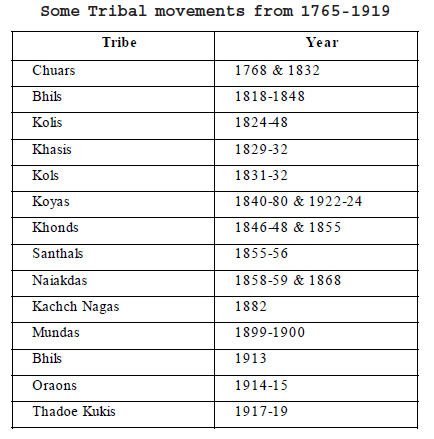
Revolts in other parts of India
- The Naikda forest tribe in Gujarat attacked a police station in 1868 with a view to eliminate the British and establish Dharma-raj. In 1900, in Vizagapatam Agency, a Konda Dora named Korra Mallaya claimed to be the incarnation of one of the Pandava brothers of the Mahabharata and assured the people of turning out the British.
- The tribals Koya and Konda revolted against their overlord, who was under British protection. Their major revolt occured in 1879.
- The Bhils in Rajasthan fought for the establishment of a Bhil Raj in 1913. The Rampa region north of the Godavari river witnessed gurilla warfare between the English and semi-tribal inhabitants of the region under the leadership of Alluri Sitarama Raju from August 1922 to May 1924.
- Thus, a large number of tribal revolts took place during the British rule. The primary grievances of the tribal people almost at every place were interference in their cultural and economic lives by the people of the plains of the British.
|
75 videos|322 docs|78 tests
|
FAQs on Notes: Colonialism & Tribal Societies - Social Studies & Pedagogy Paper 2 for CTET & TET Exams - CTET & State TET
| 1. Who are tribals and what is their relationship with colonialism? |  |
| 2. How did colonialism impact tribal societies? |  |
| 3. What is the significance of tribal societies in the context of CTET and State TET exams? |  |
| 4. How can teachers incorporate tribal perspectives in their classroom teachings? |  |
| 5. What are some key initiatives taken by the Indian government to support tribal communities? |  |
















